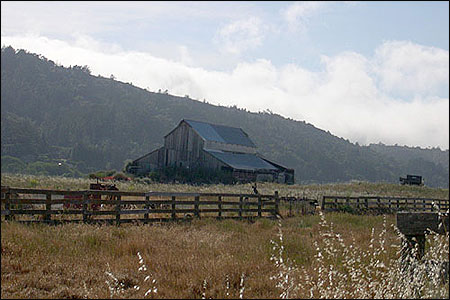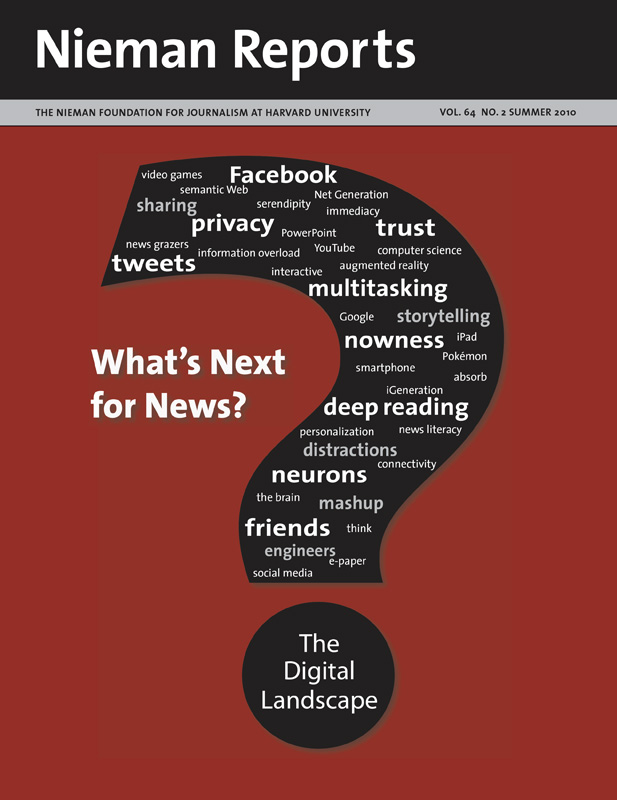
Places have stories to tell, and technology is likely to help us connect what we see—like this old barn—with stories about people and events that happened here. Photo by Krissy Clark.
“To be rooted is perhaps the most important and least recognized need of the human soul.”
— Philosopher Simone Weil
Once upon a time I had a vision in the Utah desert and saw the future of journalism. (At least, part of its future.) The vision came while I was deliriously hot, driving west of Salt Lake City across a vast stretch of land where almost nobody lives. But there was this house off in the distance. What was it doing there? I couldn’t stop wondering. Who lived in it? Why? It was a familiar feeling, one that fuels my journalism—a deep curiosity about a place and the people who inhabit it.
In my delirium, I had the strange urge to click on the house as a person might click on a hyperlink. I wanted to find out more about the house, its inhabitants, and the desert surrounding it. This urge was delusional, of course. The landscape is not made of hyperlinks; we can’t click on things we see in the world to learn more about them.
At least, six years ago, when I had this vision, we couldn’t.
Before I go any further, let me back up. This drive through Utah was not the first road trip to shape my vision of journalism. I became a journalist via road trips. In the late 1980’s, my father and I took a series of drives on weekends, together in his beat-up brown Mercedes. I was young and curious; he was old and sick with the emphysema that would later kill him when I was in high school. We drove because he had things to show me, most of all the land surrounding the San Francisco Bay, where our family has lived since 1848. I was navigator, squinting over maps, fingering shorelines, and tracing roads. As I looked out the window, my dad told stories of what we saw.
Down that road, in the little town of Birds Landing, were the ruins of my great-great-grandfather’s store, which supplied gold-seeking forty-niners. (Now the building sits in the shadow of an industrial wind farm.) Up that hill, on Vallejo Street in San Francisco, was where my dad and his mother before him grew up. (My great-grandparents moved into the house after their original house was damaged in the 1906 earthquake.) Past that tollbooth—see it through the fog?—was the place where as teenagers, my dad and his best friend climbed up the base of the Golden Gate Bridge (or so they told us) while it was under construction.
It was on these trips that I first fell in love with a place and its people, and I understood that a landscape is made of stories over time, layer upon layer, like geologic strata.
A year after graduating from college, I saved up for a bicycle ride across America with my best friend. We pedaled from California to Massachusetts and camped in the yards of people we met along the way. We had breakfast with roughnecks living large off the gas boom in Wyoming. The noise and lights from their rigs kept the town up at night. We stayed with a family who raised hogs in Minnesota but struggled to compete with corporate farms. We rode through an impoverished Indian reservation and met locals who hoped a casino might help. We hit the Atlantic Ocean, and I didn’t want to stop.
But I had figured out that what I liked doing—meeting people, asking them questions, learning about the joys and frustrations of the places they lived—had something to do with journalism. Since then, over the course of my career I have let these instincts and values guide me. I have been a student of how land shapes people and how people shape the land. I’ve learned to ask simple questions that often lead to surprising answers—and interesting stories. Why did San Francisco become the gay-friendliest city? What happens to a cow town when the cows are all gone? What drives a city to court a nuclear bomb factory? What is it like to live in the foreclosure capital of the U.S.?
Mapping the Journey
There is another thing all those road trips taught me. Maps are powerful tools. In fact I’ve come to believe that the best journalism is like a map. It shows where you are in relation to others; it provides a sense of topography and can show the best path forward. Whatever the purpose is of a particular piece of journalism—breaking a story, investigating corruption, giving voice to the voiceless—when the job is done well, a new place in this world emerges or new understanding of a familiar one is gained. Effective storytelling helps citizens and communities discover where they are (sometimes by examining who they are). From there, they can better decide where they want to go.
And so I come back to that vision I had in the desert on that sweltering drive through Utah when I noticed that faraway house and wanted to click on it. While that would have seemed a ridiculous idea a decade ago, now it is nearly possible. Look in your purse or pocket. There’s a good chance you’ve got a smartphone in there—equipped not only with Internet access but also with GPS, a compass, and an accelerometer. It can tell you where you are, help you get to where you’re headed, and even let you know how fast you are going in getting there.
Technology like this is changing the media landscape, and the shift has got me thinking hard about the actual landscape under our feet—the streets and land we live on, and the layers of stories heaped upon them. Every place has a story, and every story has a place.
So what can that gadget in your car or pocket tell you about a place right now? The answer: a lot of facts, figures and user-generated reviews.
- An application called Wikitude allows you to point your phone in the direction of a mountain range or historic building and read a Wikipedia entry about it.
- Twitter and Foursquare and Gowalla can show the tweets and fleeting thoughts of people who have stood where you’re standing.
- Yelp and Urbanspoon let you use the camera and GPS on the iPhone to create a window of augmented reality that displays comments about the restaurant in front of you.
- EveryBlock reveals data including crime statistics, property values, and municipal permit applications on a city block.
All of this is useful information. But as a journalist it’s worth considering two things: Too much information can be too much of a good thing, if it’s not vetted and curated. And a place’s story is more than the sum of its data.
In other words, facts and tweets and user-generated encyclopedia entries and reviews are not the only things to know about a place. There are also well-researched, well-crafted stories: the dramas, hopes and concerns of the people who live there and the forces that affect them.
At such a challenging time for journalism, this is good news.
Now imagine this scenario. I’m driving down Interstate 80 through the Utah desert and I see a house. I wonder about it. So I point my phone in its direction and click; I find a story, perhaps from The Salt Lake Tribune, about the man who built it. Maybe he worked at the Wendover Air Force Base, where the Enola Gay crew trained before they dropped the first atomic weapon in 1945. And the desert surrounding this house? Courtesy of the Deseret News, I learn that the land may soon be home to a radioactive waste dump, just over the ridge over there. A few miles behind me, that’s where a skydiver fell from the clouds and broke his pelvis last summer. And the town up the road may look sleepy, but in the last few years it has had the highest job growth in the nation.
Imagine pointing your smartphone at the desert and hearing a stream of stories about the people who live and work nearby. Imagine clicking on the things you see in the world as though they are hyperlinks. Imagine hearing a podcast as you move through a landscape that would tell you the stories of that place.
Telling the Stories of a Place
Every place has a thousand stories that can help us understand our world and make decisions as citizens. Journalists tell these stories every day and news organizations have archives full of them. But there could be more efficient, effective and creative ways to link these stories to the places where they are rooted. Reporters and newsrooms could geotag their stories and archives in a coordinated way so that when someone goes to a particular place or looks at a map of that place, she could get an aggregate of relevant, well-researched content.
I’ve gotten glimmers of the power of telling a story at precisely the right time and place and heard back about how the experience enriched my audience’s understanding. A few years ago, a woman e-mailed me to say that she had been driving past Santa Monica beach when she heard my radio story about a 97-year-old man who flies homemade kites there. She found him and introduced herself. Then there was my friend who told me he caught my story about the drought’s effects on Lake Mead just as he was driving past the reservoir toward Las Vegas.
Those intersections of story and place were just lucky coincidences. We could build tools that ensure those moments. By harnessing the fleeting but powerful investment that people have in a place when they are physically in it, we fuel curiosity and give deeper meaning to what is discovered.
We live at a time and in a world in which people can become so glued to their gadgets they forget the place where they are standing. But a reporter equipped with the right geospatial devices has a unique opportunity to reconnect people to place.
Combine storytelling skills with location-aware tools, and the interactive landscape of my desert hallucination is nearly possible. I see a world where narratives are draped on a landscape, and the news of a region is not just about what’s new. Place provides an alternative organizing principle for journalism, prompting questions about what forces—economic, political, environmental, cultural, personal—shape one spot in the world. “Where” has always been one of the fundamental questions guiding journalists, along with who, what, when, why and how. Now the answers to those questions—in the form of stories—might soon emanate from the landscape itself. “If these walls could talk,” the saying goes. I’m here to tell you: They can.
Krissy Clark is a contributing producer for American Public Media’s documentary unit, American RadioWorks. She is based in San Francisco and was a 2009-2010 John S. Knight journalism fellow at Stanford University, where she focused her study project on geographically aware journalism.


